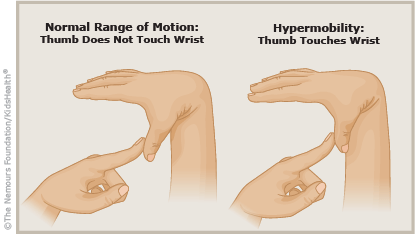A to Z: Benign Joint Hypermobility Syndrome

May also be called: Joint Hypermobility Syndrome; Hypermobile Joints; Loose Joints; Benign Ehlers-Danlos Syndrome; EDS-Hypermobility Type
Benign joint hypermobility (hi-pur-mo-BIL-ih-tee) syndrome is an inherited connective tissue disorder in which joints can move beyond their normal range with little effort.
More to Know
Joint hypermobility is the ability to move joints — especially the elbows, wrists, fingers, and knees — beyond the normal range. Some people call this being “double-jointed.”

Joint hypermobility is common in children but usually decreases as people age. However, some people’s joints stay hypermobile even after they reach adulthood. When this occurs in the absence of underlying disease, it’s often due to benign joint hypermobility syndrome (BJHS), a genetic condition that causes “loose” connective tissues (cartilage, ligaments, and tendons).
In addition to hypermobile joints, people with BJHS often have chronic joint pain, varicose veins, hernias, joint dislocations, or rectal prolapse (a condition in which part of the rectum drops down through the anus). Women with BJHS may also have uterine prolapse (a condition in which part of the uterus slips down into the vaginal canal).
Treatment for BJHS is focused on treating pain and other symptoms as they arise. This may involve medications or, rarely, surgery. Exercises that strengthen and stretch muscle groups can help keep joints more stable and decrease the likelihood of dislocations and other symptoms.
Keep in Mind
There is no cure for BJHS, but it doesn’t get worse over time. In some cases, joint hypermobility and other symptoms of BJHS will decrease as someone gets older. Muscle conditioning, protective braces, and avoiding high-risk activities can help reduce the risk of joint injuries.
All A to Z dictionary entries are regularly reviewed by KidsHealth medical experts.
